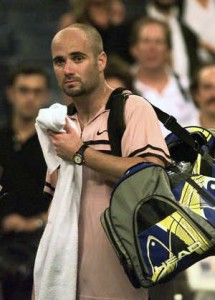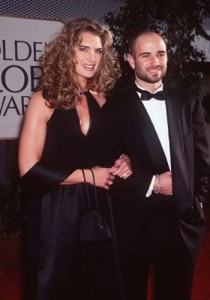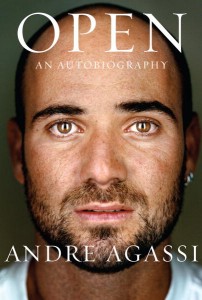Andre Agassi: An “Open” and Shut Case

After being the number one player in the world in 1995, Andre Agassi had fallen to number 141 in 1997.
It goes without saying that drugs are bad – even recreational drugs. That is why it is impossible to get them, right? If drugs are a cancer to our society, then, of course, as a society we are doing everything in our power to counter them, protecting our children, our community, our cities and our states.
It is much the same for harmful weapons like guns. We do not allow children or citizens who may harms others access to something that presents such an immediate and present danger. Right?
As a people, as a community, we are doing everything in our power to create a safe environment for all people living within our boundaries. We treat everyone who breaks the law the same within our equal and passionate justice system.
If you believe the preceding statements are true then you live in la-la land with the rest of the self-appointed name-callers and blame gamers who hug today’s headlines. It is these holier-than-thou critics who instantly rise to criticize someone else’s behavior who irritate the lining in one’s stomach.
Recently Andre Agassi had the courage to stand up and confess his addition to methamphetamine during his professional tennis career. In fact he states that in 1997 he was caught using crystal meth by the ATP during a routine drug test.
When he lied about the circumstances, saying he accidentally ingested the drug by drinking his assistant “Slim’s” spiked soda, he compounded his guilt by lying. Because he imbibed inadvertently, according to his statement, his probable 3-month suspension was dropped and the matter never came to light.
Never assume you understand what motivates people to reveal their secrets. Andre Agassi chose to admit this infraction in his upcoming autobiography, “Open,” which will be released this week.
What he reveals is that he was a young man in deep trouble. He needed help and he turned, like so many young people do, to drugs. His father was an unforgiving, self-centered man who drove and abused Agassi. It appeared as well that Agassi’s marriage to Brook Shields was built on an illusion.

Many blamed Agassi's tennis woes on Brooke Shields, but it now appears that drugs may have been a bigger factor.
Agassi’s hatred of his father and subsequently tennis became reflected in his on court demeanor. Agassi was losing his grip on his tennis fortune, his life, his marriage and ultimately on his integrity as a person.
“Slim” we learn in the course of reading is the person who introduced Agassi to the illicit drug. Like most who come to depend on mood enhancing substances, Agassi grew dependent upon the euphoria provided through crystal meth.
Agassi was the former number 1 ranked player in the world in 1995 but by 1997 had dropped to number 141. He was barely playing tennis – mainly just appearing at tournaments to honor a commitment and collect a check. He was destroying himself deliberately.
The press treated him with disgust and disdain. Many blamed the Agassi free fall as a result of his marriage to Brooke Shields, saying the American’s interest in tennis took a leave of absence after the April nuptials.
There was no hint of the real problem – Agassi’s addiction.
So why confess it now? Why after years of redemption and good work would this man suddenly invite the level of abuse he currently endures?
It is laughable to listen to certain commentators suggesting that Agassi is doing it for the money and for the publicity. He does not need the money and this is not the kind of publicity any major sports figure seeks out.
Martina Navratilova announced that she was shocked – as were we all. She goes on to compare Agassi to Roger Clemens who is accused of using steroids throughout his major league baseball career. The difference is that anabolic steroids are performance enhancing drugs.
If Clemens and others used these substances to give them an advantage over other athletes, then that is another matter. No one can claim that crystal meth in any way aides one’s performance. Quite the contrary. It causes you to fall from number 1 in the world to number 141 in terms of tennis reality.

Agassi admitted his drug history in his new autobiography, which will be released on November 9.
The fact is that Agassi put his addiction behind him and devoted himself to redeeming his tennis career, his life and his commitment to his community. He became an ambassador for tennis and played on until his body could no longer tolerate the constant pounding and rigors of the tour.
He created a foundation and devoted his considerable resources to fund a school for underprivileged kids in Las Vegas. His ambition is to improve educational resources for the entire state of Nevada.
To suggest that it is to Agassi’s advantage to confess all is patently ridiculous. He is doing so to highlight a real problem in sports and in our society today. He sets himself up to show that it is possible to break a most addictive habit, reform and come back from hell stronger than ever.
He is illustrating an option and giving hope to the youth who suffer from low self esteem and lack of parental support.
It is easy to sit back and do nothing and rest on your laurels. It is quite something else to risk everything you have accomplished to make a statement about rising above your circumstances and doing what you can to promote healing.
These actions illustrate that there is more to this man than his tennis career. Andre Agassi wishes to continue to inspire young people by letting them know that the true danger lies in trying to escape the world rather than dealing with it head on.
JA Allen is a regular contributor to Sports Then and Now.
Editor’s Note: Sports Then and Now has been provided an advance copy of “Open” and will be publishing a full book review early next week.
I filled in a online application and with a few initial mistakes it absolutely was permitted.
If they obtain next salary and all they can pay could be the
interest payment due, then a loan continues to accrue interest and comes over.
I can not imagine being an athlete at that high of a level needing help from crystal meth rehab centers at the same time. I can hardly get up and down the court without any substance abuse issues myself.
I’m excited to uncover this great site. I need to to thank you for your time due to this fantastic read!!
I definitely really liked every little bit of it and I have you bookmarked to check
out new stuff in your blog.
There are people addicted to drugs especially those who are in the sports field. I have heard that they are using these drugs in order to produce extra energy and strength with which they can win the competition. They are not aware of the harmful health diseases that are targeting them. Learn Hebrew
awesome site.
thanks for sharing great post.
nice post
Cool and mishto blog
It is an obvious thing to see if we are having these types of cases which are not having any proves. When there is no prove it is being automatically open and shut case for everyone.